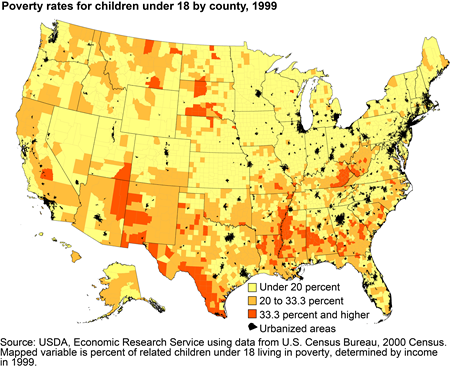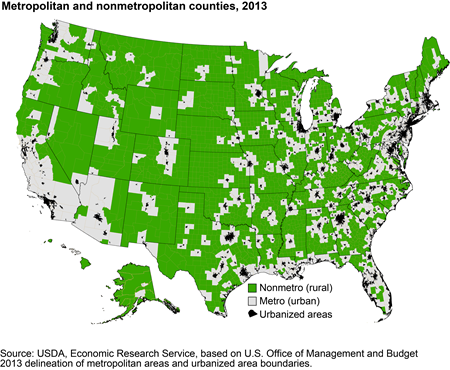Rural Child Poverty Chart Gallery
Note: Updates to this data product are discontinued. Over 1 in 4 rural children are living in families that are poor, according to the official poverty measure, up from 1 in 5 in 1999, but this change was uneven across the rural landscape. Counties with high vulnerability to child poverty, those with both low young adult education levels and high proportions of children in single-parent families, were generally the most hard-hit by the recession of the past decade and experienced substantial increases in their already high child poverty rates. Along with the recession, an increase in rural children in single-parent households, continuing from the 1990s, was a major contributor to the rise in child poverty after 2000. Three factors that shape the geography of high and increasing rural child poverty are explored below: economic conditions, young adult education levels, and family structure. This collection of maps complements the July 2015 Amber Waves feature, Understanding the Geography of Growth in Rural Child Poverty.
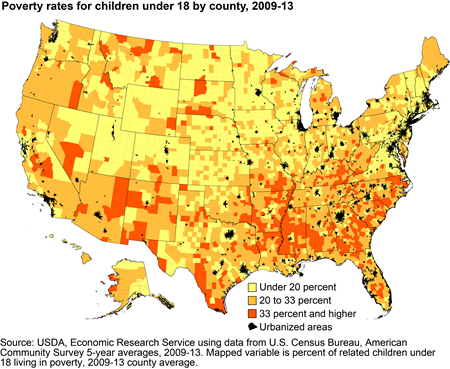
Child poverty rates varied considerably across nonmetropolitan (rural) counties according to 2009-13 county averages (data on poverty for all U.S. counties are available from the American Community Survey for 5-year averages). One in 5 rural counties had child poverty rates of over 33 percent in 2009-13. Overall, county average rates of child poverty rose from 20 percent in 1999 to 25 percent in 2009-13, with the proportion of counties with child poverty rates of over 33 percent doubling in this period. Meanwhile, estimated child poverty rates declined in 1 in 5 counties. To better understand this diversity of experience, we examine three factors shaping the geography of the change in rural child poverty over this period: changing economic conditions, young adult education, and family structure.
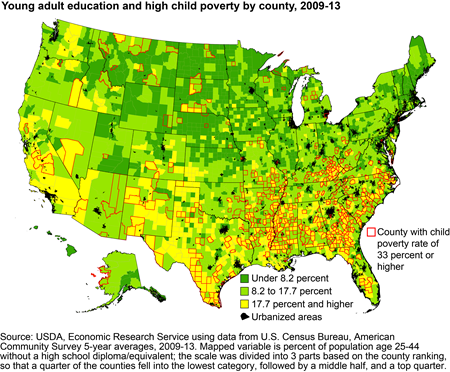
Rural education levels have been rising and this is reflected in county statistics. The top quarter of nonmetropolitan counties in young adult (ages 25-44) high school dropout rates in 2009-13 had poverty rates of nearly 18 percent or more. While high, the number of counties with rates this high had fallen from 841 in the 2000 Census to 493. The economic hardship associated with low education levels is reflected in child poverty statistics. Slightly over half of the counties with child poverty rates of over 33 percent were also counties in the top quarter in young adult high school dropout rates. At the same time there are many counties with low education levels, often with substantial Hispanic populations, including mining counties in west Texas and large scale agricultural counties in southwest Kansas, that have lower child poverty rates.
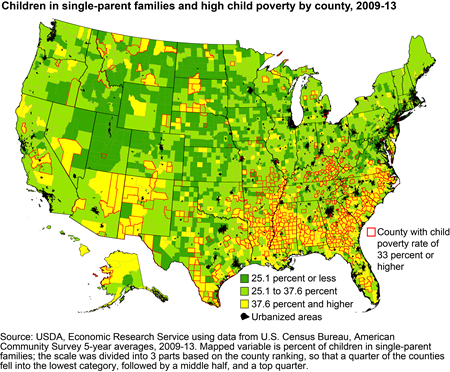
The proportion of children living with only one parent is both a reflection and a cause of economic hardship. This proportion has risen in recent decades, particularly in rural areas. Using a constant county definition of rural (nonmetropolitan in 2013), the rural county average proportion of children in single-parent families rose from 19 percent in 1999 to 32 percent in 2009-13, about the same as the metropolitan county average. There is a strong association between family structure and child poverty. Among the rural counties where the proportion of children in single?parent families exceeded 37 percent (the highest quarter of counties in 2009-13), 58 percent had child poverty rates exceeding 33 percent. On the other hand, among the rural counties with the lowest proportions of children in single-parent families (25 percent or less), only 3 percent had child poverty rates that high.
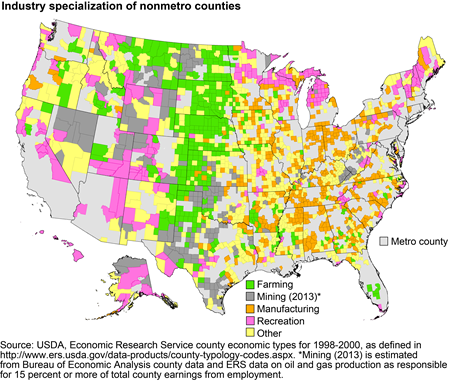
Nonmetropolitan counties have highly diverse industrial specializations. Where farming was once almost synonymous with rural, the predominance of farming as an industry in rural areas of the United States is now largely confined to the Plains States. On average in 1998-2000, manufacturing predominated in many rural counties east of the Mississippi as well as in a scattering of counties further west. Manufacturing has historically been a boon to rural low-skill workers, offering higher pay than other industries and often steadier work. But manufacturing was especially hard hit during the recent economic downturn, and that was reflected in the child poverty statistics for manufacturing-dependent counties. In 1999, these counties had average child poverty rates of 18 percent, 2 percentage points below the overall nonmetropolitan average. Their child poverty rates moved substantially upwards over the subsequent decade, reaching nearly 27 percent in 2009-13, a greater increase than observed in any other industry type of county.
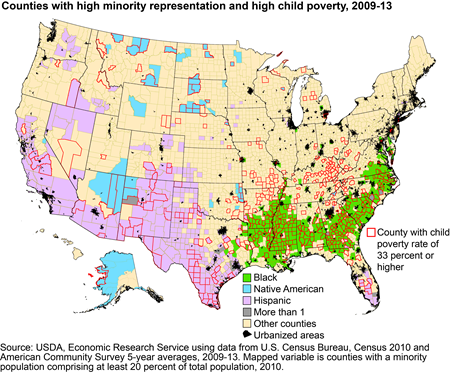
Over 1 in 4 rural (nonmetro) counties had a minority population?Black, Hispanic, or Native American?comprising at least 20 percent of the total population in 2010. The number of rural counties with over 20 percent of the population reporting themselves as Hispanic increased by a third between 2000 and 2010, to reach 210 (keeping the same 2013 definition of nonmetropolitan). Rural Native American counties also increased, from 46 to 55. However, the number of Black counties declined, from 285 to 277. Black counties were especially hard hit by the decline in manufacturing jobs in the 2000s, a decline that accelerated with the recession of 2007-09 and its aftermath. Child poverty, more dependent than poverty in general on labor market conditions, rose considerably in Black counties. The proportion of these counties with child poverty rates of 33 percent or more rose from a third in 1999 to nearly two thirds (66 percent) in 2009-13.
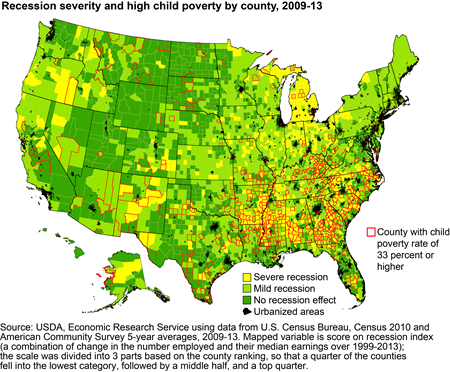
The first factor, the economic conditions of the period, was most marked by the severe recession of 2007-09, but involved highly uneven impacts across rural areas and over time. After booming in the 1990s, rural manufacturing jobs began to disappear at the beginning of the 2000s, a trend that accelerated with the recession. While many local economies dependent on manufacturing had severe setbacks, other rural areas experienced booms in oil and gas mining and never felt the recession.?In general, rural counties with severe recession had much higher average child poverty rates in 2009-13 (31 percent) than they had in 1999 (22 percent). Counties largely immune from the recession, with growth in both employment and earnings, did not, however, have a corresponding decline in child poverty, which remained at 20 percent for the period. These?results are similar to the results for the generally prosperous farm and mining counties in suggesting that economic growth itself was largely unable to reduce child poverty over the past decade.


